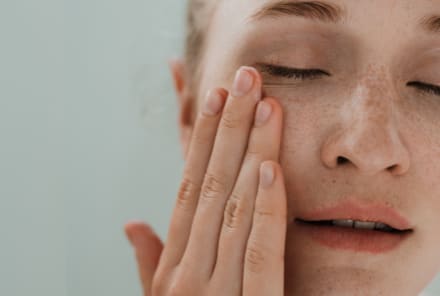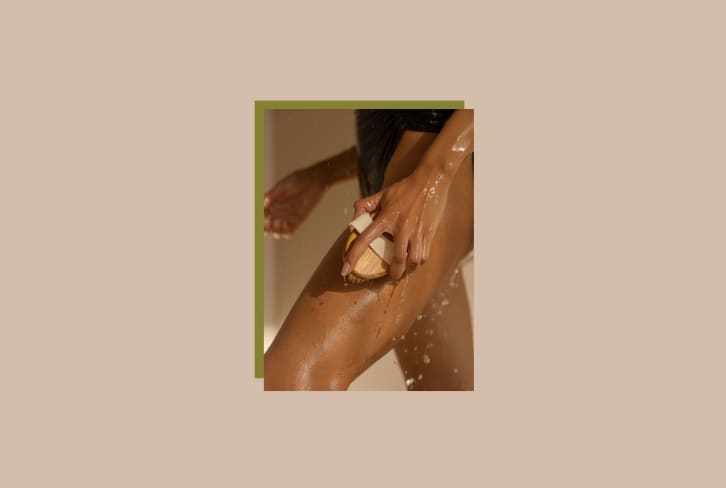Advertisement
Smooth Skin: How To Get It With 11 Tips From Dermatologists

Naturally smooth skin is one of those things we take for granted when we have it: Washing our face at night or slathering on a tonic is just so effortless—perhaps even thoughtless. When your skin is soft, you tend not to think about it as much; there is simply less to preen about. Then, when you feel a bump, fold, or scar, many people's immediate reaction is: OK, how do I smooth this out again?
And listen, consistently having smooth skin takes patience, consistency, and—if we're being honest—a pinch of luck. Smooth skin may feel effortless—but it hardly ever actually is. Not to mention, there are a plethora of reasons your skin feels less than taut. Texture issues can arise from acne (in the form of pimples and pustules—or later as scars), rosacea (a common misdiagnosed symptom is small, whitehead like bumps), eczema (those notorious dry, flaky patches), enlarged pores (which can create rougher, orange-peel-like skin), and fine lines (which create etches and folds). And what will work for acne may not work for something like eczema. Oh, we must also mention that many people have a blend of a few skin conditions or concerns—so finding the right routine takes some smart cocktailing. All of this is to say: Achieving smooth skin involves, well, a bit of nuance.
But there are ways to keep your face soft, in the short term as well as long. Here are some of the best expert-approved ways out there—all-natural, of course.
Exfoliate regularly—but don't overdo it.
Let's get back to basics: Exfoliation is the process of removing excess dead skin cells at the top layer of the skin, either manually (via physical scrubs) or chemically (via acids and enzymes). And the thing is, the epidermis actually uses dead cells as a layer of protection (read: we want those skin cells there!). The problem arises, however, when they accumulate too much and skin appears dull and said cells clog pores or lead to an overall uneven appearance.
And on the flip side, additional problems arise when you remove too much of that layer, as that will inhibit skin-barrier function. That's why finding an appropriate balance for your skin is key! "The most important tip is that 'less is more.' You want to exfoliate just enough to increase cell turnover and reveal fresh new skin," Ife Rodney, M.D., a board-certified dermatologist and founder of Eternal Dermatology, previously told us about exfoliating too much. "But be sure to not scratch or damage your skin by overusing these devices or products." Let us remind you: Damaged skin appears uneven as well.
She notes that the breakdown usually goes as follows: Those with oily skin can tolerate about three times a week, those with combination or "normal" skin can likely stand two, and those with sensitive or dry skin should only do once—if that.
If you're looking for exfoliators, there are certainly plenty of options available. Look for one suitable for your skin type. If you have dry or irritation-prone skin, a gentle lactic acid should be your go-to as it acts as a humectant as well as an exfoliator. Glycolic acid, another AHA, is great for those with combo skin: It's a little stronger than lactic but still has hydrating properties. If you have oily or acne-prone skin, reach for the BHA salicylic, which can break down oil.
Invest in the right topical ingredients.
It's not just acids that can help smooth skin—there are a plethora of ingredients that can help plump skin, ease fine lines, and remedy dry, rough patches. This will be particularly helpful if your texture concerns stem from maturing skin or inflammatory skin conditions, like rosacea and eczema.
To start, you want to look for fatty acids, which act as the building blocks for the cells—they can help build up a strong skin barrier, resulting in a smoothed-out appearance. You can also opt for things like ceramides, which are naturally occurring lipids in the skin; these can help mend damage in the lipid barrier (which can be the result of eczema). Or you can try the popular squalane. This lipid is also naturally found in your skin's sebum and is something of a multitasker: Research shows some advantages for the skin as an emollient and antioxidant and for hydration1.
Finally, look for potent antioxidants like vitamins C and E. Not only do these antioxidants prevent free radical damage, or the source of many texture issues to begin with, but together they can help produce and stabilize precious collagen. As Julia T. Hunter, M.D., founder of Wholistic Dermatology in Beverly Hills previously told us: "If you don't have vitamin C, your collagen can't cross-link to lift and tighten skin." Collagen, which we'll dive into a bit deeper later, is a structural protein in the skin that keeps things in place—when we lose it, skin will sag, pores appear larger, and we develop wrinkles.
Find a retinol that works for you.
Retinol is a class of ingredients that are technically a vitamin A derivative. It has become a dermatologist favorite for many reasons: It can help treat moderate to severe acne, it builds collagen, and it increases turnover. (All very important when achieving smooth skin.) For example, the retinol molecule "is able to penetrate the skin's surface and activate a variety of cells in the skin," explains board-certified dermatologist Melanie Palm, M.D., MBA. "In the second layer of the skin, retinol penetrates cells called fibroblasts—the major collagen builders of our skin."
Retinols are not for everyone—some will simply find them too irritating to use—but there are plenty of modern variations and strengths out there, so most people will likely be able to find one that works with their skin type. If you find yourself in need of a stronger version, you can visit your derm for a prescription (like Retin-A), or you can find an OTC version buffered with hydrating actives.
Oh my, and speaking of hydrating.
Always moisturize.
Hydrated skin is happy skin. It is so important that famed esthetician Alicia Yoon, founder of Peach & Lily, calls it "the key to life for our skin."
By keeping skin moisturized, you're accomplishing a few things. The first is that you're keeping your dermis full of water, which keeps you looking youthful, plump, and vibrant. From there, hydration helps support skin-barrier function. When your skin-barrier function is compromised, or just generally weak, a whole host of problems arise, most of which can lead to texture changes in the skin. And as a result of all this moisturizing, you can actually help prevent premature fine lines.
Hydrated skin also leads to reduced breakouts. By now, I feel most of us have stopped buying into the myth that acne-prone folk can't moisturize. However, they just may not be aware of how important hydration is to treat acne. When your skin is dehydrated, inflammation tends to follow. That inflammation, says Yoon, "can release a hormone that can actually tell your sebaceous glands to produce more oil." It doesn't stop there: According to Yoon, this hormone can also kick-start what's known as retention hyperkeratosis2—where dead skin cells become cohesive and don't shed as normal (almost like they're "stuck" to your face). And when those dead skin cells become trapped within your pores (along with the excess sebum mentioned above), that can lead to concerns like sebum plugs, blackheads, even inflamed pustules.
Soothe inflammation with biome-friendly ingredients and antioxidants.
So many of our skin care concerns boil down to one thing: inflammation. Inflammation breaks down structural proteins in the skin, damages the epidermis, triggers acne, causes conditions like rosacea and eczema, and sends the body into oxidative stress.
The problem is inflammation comes from a lot of sources. Internally, it comes from stress, eating a less than ideal diet, and health issues. Externally it comes from physical irritation, UV exposure, pollution, and an unbalanced skin microbiome. There are certainly plenty of lifestyle adjustments to make to deal with inflammation (which we'll explore soon), but topically you can look for biome-friendly ingredients (like pre-, pro- and postbiotics) and antioxidants.
Biome ingredients work with your skin's natural microflora to naturally balance out the living organisms on the skin, resulting in better barrier function and reduced irritation. Antioxidants help neutralize free radicals and oxidative damage, which is the primary cause of inflammation of the skin externally.
Stay hydrated.
You know how people with perpetually glowing, radiant skin always say their top tip is to "drink enough water"? For those of us who deal with skin conditions, that advice tends to elicit an eye roll. (Rightfully so! Glorious skin is typically the result of many factors, not just adequate hydration.) However, there is something to the idea that drinking enough water does translate to better skin. Here's why: Studies have shown time and again that proper hydration can increase your dermal thickness3. When you have thick skin, it's more adept at dealing with inflammation and appears smoother. The more you know!
Wear SPF.
As we age, many of the issues that we develop in our skin can likely be traced back to photodamage (also called UV or sun damage). "Ultraviolet radiation is unequivocally carcinogenic," explains board-certified dermatologist Heidi Waldorf, M.D. "If you don't care about cancer, think vanity—UV rays are the primary cause of the texture and color changes of skin aging." And while you can't turn back the clock and redo any misspent sunbathing years, you can be smart about preventing any future damage. Find a mineral-based option that matches your skin tone, and be diligent about applying it daily.
Remember to rest.
The importance of sleep cannot be stressed enough. We could really go through the plethora of reasons it's good for our bodies, but we'll stick to skin here. Your skin, being a living organ, is constantly going through a regeneration cycle. This happens most prominently when you sleep. It does so because the skin sees a surge in HGH (human growth hormone) in the nighttime sleep cycle. The release of HGH helps rebuild body tissues4 and spurs increased cell production to replace cells that were damaged throughout the day. When you don't sleep, or don't sleep enough, you are losing precious hours in which your body would go through this process.
Not only that, but lack of sleep throws our bodies into oxidative stress, which can cause chronic inflammation if your poor sleeping habits are long term. You'll likely start to see changes in your skin like sallowness, dullness, breakouts, and signs of premature aging.
Eat a balanced diet.
What we eat affects us in both positive and negative ways. Let's get the bad stuff out first: Eating a diet high in inflammatory foods—like processed meat, dairy, sugar—puts a lot of strain on our bodies. It does so by changing our gut flora, which can cause your lining to become damaged and literally "leak." This is when you get chronic inflammation, which may show up in your skin. So that's what you don't want to do.
On the flip side, you can actually eat to benefit your skin by eating low-inflammation foods (to avoid the dreaded "leaky gut"), as well as antioxidants (to protect the body from free radicals), as well as nutrients to hydrate internally.
Stay active.
Exercise and your skin health have a very strong connection, which essentially comes down to improved circulation5. See, your skin needs nutrients to thrive—but being the outermost layer of the body, it's often the last to receive it. One way to help ensure your skin is receiving adequate blood flow, and therefore oxygen and nutrients, is through exercise.
See a professional.
And if all else fails? Enlist the experts. Dermatologists and estheticians can provide prescription-strength treatments (when needed), as well as high-tech, highly effective treatments and facials you may not be able to master at home. And depending how thorough they are in your consultation, they can also help you get the root of your texture issues—as we can so often misdiagnose ourselves, leading to improper treatments or products.
Of course, it's not always feasible for everyone—that we understand—but if it is within your means and you live in a location with access to an expert, it may be worth a visit.
5 Sources
- https://www.ncbi.nlm.nih.gov/pmc/articles/PMC6253993/
- https://www.sciencedirect.com/topics/medicine-and-dentistry/hyperkeratinization#:~:text=Retention%20hyperkeratosis%20occurs%20when%20keratinocytes,visible%20on%20the%20skin%20surface.
- https://pubmed.ncbi.nlm.nih.gov/18489334/
- https://journals.sagepub.com/doi/abs/10.1177/026921558700100313?journalCode=crea
- https://www.ncbi.nlm.nih.gov/pubmed/481154
Watch Next
Enjoy some of our favorite clips from classes
Enjoy some of our favorite clips from classes
What Is Meditation?
Mindfulness/Spirituality | Light Watkins
Box Breathing
Mindfulness/Spirituality | Gwen Dittmar
What Breathwork Can Address
Mindfulness/Spirituality | Gwen Dittmar
The 8 Limbs of Yoga - What is Asana?
Yoga | Caley Alyssa
Two Standing Postures to Open Up Tight Hips
Yoga | Caley Alyssa
How Plants Can Optimize Athletic Performance
Nutrition | Rich Roll
What to Eat Before a Workout
Nutrition | Rich Roll
How Ayurveda Helps Us Navigate Modern Life
Nutrition | Sahara Rose
Messages About Love & Relationships
Love & Relationships | Esther Perel
Love Languages
Love & Relationships | Esther Perel
-v1646695196476.jpg?1148x800)

















